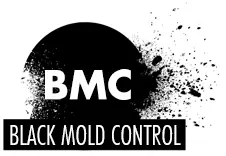Does your building or house have black mold in garage, and if so, how would you remove it? Stachybotrys chartarum is a type of fungus that can be found indoors or outdoors. It looks black or greenish-black, and can leave a musty smell in the air. The fungus reproduces through spores, which can travel and settle in an area, and then continue to grow and multiply.

Spores can produce mycotoxins, which are toxic chemicals that harm people, pets and even plants; they have been linked to deaths in humans. They can exacerbate asthma and cause health issues, including coughing, runny nose, sneezing and lung infections.
To fight the infestation, you need to find, clean up and remove it, followed by preventing anymore from growing.
Table of contents
- Black mold growth
- Looking for mold on garage wall, floor or ceiling
- Mold on garage door
- Cleaning black mold in garage
- Black mold removal and prevention
- Consult a apecialist
Why does black mold grow in your garage
The fungus needs moisture and food to exist, and your garage can be a perfect source of both. Food includes paper, drywall, wood, carpeting and insulation- all of which can contain cellulose and be porous. Dirt on a concrete floor is a food source.
Garages are usually dark. Leaky pipes along the ceiling allow moisture to build up, as well as leaks in the roof and floor cavities. If fiberglass insulation is used, moisture can form on it- cellulose insulation isn’t any better. If your car has snow on it, it can raise humidity levels. Moisture means growth. Read this article on moisture and mold. [external link]
Looking for mold on wall, floor and ceiling
The first step in fighting black mold is locating it. It is spotted easily if there’s a large amount of black color on a surface.
However, the fungus can hide behind drywall and wallpaper, inside of wall cavities. Eaten drywall paper and wooden studs behind walls is a telling sign, especially if they start turning black.
Also, it can eat carpeting and the wood underneath, and make its way inside the floor cavity. If your garage has concrete floors, puddles of water cam attract fungus.
Warm air can contact cold air, and condensation can form on the ceiling, allowing for black fungal growth – this can happen during the summer or winter. If your HVAC system is badly insulated, the fungus can grow in the air ducts on your ceiling.
You can use a mold testing kit to check for the quantity present in your garage.
Don’t forget the garage door
Rain or snow can get in through an open garage door, or if the seal is not secure enough. If there is heavy rain or snow outside, all of that water can accumulate towards the bottom of the door. Gutters above the door can also result in this problem.
Condensation in door vents can be a problem, along with holes in the door. In the summer, be careful when spraying your car that you do not point the nozzle towards the garage door or walls- excess water means more moisture, and can also lead to water damage.

Cleaning black mold in garage
The term mold remediation refers to the cleaning up of mold as well as preventing it from returning. To clean properly, you’ll need personal protective equipment, which includes coveralls, gloves, goggles, a NIOSH certified respirator, heavy footwear and anything that covers the head.
When fungus is disturbed, it rapidly releases spores which go airborne and can travel to other areas of the building or house and land on walls, or even be inhaled. A N95 respirator keeps out 95% of particles; a N99 respirator or N100 respirator does an even better job, and is useful for cleaning spacious areas.
Covering or removal of food, furniture and electronics is important, as these can get easily damaged.
You might also need the following: a mold removal kit, disinfectant, cleaning spray, saw and fogger.
Disinfectants are used to kill, but can’t stop the spreading of spores. That’s where cleaning sprays come in- they can encapsulate the fungus to stop it from reproducing. A fogger is used for hard-to-reach places, like inside wall cavities. A saw can cut a hole in a wall, drywall or not.
A mold removal kit can contain some of the items listed above, but isn’t comprehensive enough for bigger jobs.
Black mold removal and prevention
During removal, objects that show fungal growth need to be removed. Contaminated areas will need to be contained, using plastic to cover door openings from floor to ceiling. HEPA vacuums can filter air, and HVAC systems provide clean air circulation. Afterwards, the areas should be dried.
To prevent reoccurrences, mold testing should show low levels. Concrete floors should be checked for water puddles. Drywall that’s water-resistant is optimal. Ducts on the ceiling should stay free of dirt.
When to consult a mold remediation expert?
Do you lack the proper equipment, or are you just looking for general guidance on the removal process? Mold remediation experts have the knowledge and tools to help you to get rid of infestations. They possess the skills and experience to detect, destroy and deter the fungus from ever coming back. They are licensed professionals, and will carry out any job, big or small, by following safety protocols and thoroughly cleaning your building or house. Call one today for a free quote.
